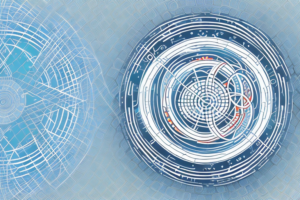What is security control inheritance in RMF?
7 min read
A layered security system with multiple layers of protection
The Risk Management Framework (RMF) is a commonly used set of guidelines for managing information security risks in government organizations. Within the RMF framework, security control inheritance is a key concept that can help streamline compliance efforts and simplify the overall risk management process. In this article, we will explore the basics of security control inheritance in RMF, its importance in risk management, as well as practical tips for implementing and managing it effectively.
Understanding the basics of security control inheritance in RMF
Security control inheritance, in the context of RMF, refers to the reuse of security controls already in place in an organization. It allows the organization to take credit for controls that have been implemented in a higher-level system or inherited from another organization, rather than reinventing the wheel and implementing the same controls again. By using security control inheritance, organizations can streamline their compliance efforts and focus on implementing only those controls that are unique to their specific systems.
An essential aspect of security control inheritance is ensuring that the inherited controls are still valid for the system at hand. Organizations must consider the unique requirements and risks associated with their systems and adjust the implemented security controls accordingly if needed. Failure to do so can lead to gaps in security and potentially increase the risk of a security breach.
Another important consideration when implementing security control inheritance is the need for proper documentation. Organizations must maintain accurate records of the controls that have been inherited and how they have been implemented in their systems. This documentation is essential for compliance audits and can also help organizations identify any gaps or weaknesses in their security posture.
It is also important to note that security control inheritance is not a one-time process. As systems and technologies evolve, organizations must regularly review and update their inherited controls to ensure they remain effective. This ongoing maintenance is critical to maintaining a strong security posture and reducing the risk of a security breach.
The importance of security control inheritance in risk management
Security control inheritance is a critical aspect of risk management in RMF because it allows organizations to achieve compliance more efficiently. Instead of implementing all security controls from scratch, which can be time-consuming and labor-intensive, organizations can use existing controls and adjust them for their specific systems. This approach saves time, resources, and enables organizations to focus more on critical vulnerabilities and risks rather than simply checking boxes.
Furthermore, security control inheritance can help ensure consistency across systems within an organization. It allows organizations to leverage their existing knowledge and expertise to implement controls consistently and systematically throughout their environment, reducing the variation and potential for gaps in security.
Another benefit of security control inheritance is that it can help organizations stay up-to-date with the latest security standards and regulations. By inheriting controls from trusted sources, such as the National Institute of Standards and Technology (NIST), organizations can ensure that their security measures are in line with industry best practices and comply with relevant regulations.
Additionally, security control inheritance can facilitate collaboration and information sharing between different departments and teams within an organization. By using a common set of controls, teams can communicate more effectively and work together to identify and address security risks more efficiently.
How security control inheritance simplifies the compliance process in RMF
Security control inheritance is also useful for simplifying the compliance process in RMF. As organizations inherit controls from higher-level systems or other organizations, they still must comply with the requirements of those controls. However, by using inheritance, the organizations can reduce the burden of documenting and testing each individual control. When properly implemented and documented, inherited controls can be used as evidence of compliance for the system at hand, allowing the organization to save time and resources while remaining compliant.
Key benefits of using security control inheritance in RMF
There are multiple benefits to using security control inheritance in your RMF implementation. Some of the most critical benefits include:
- Saving time and resources by reusing existing security controls
- Ensuring consistency across systems and reducing variation
- Streamlining the compliance process and reducing documentation and testing efforts
- Enabling organizations to focus on critical risks and vulnerabilities
Common misconceptions about security control inheritance in RMF
There are several misconceptions about security control inheritance in RMF. One common misunderstanding is that inheriting controls means an organization is off the hook for compliance. However, even when controls are inherited, organizations are still responsible for ensuring their effectiveness and compliance with all relevant regulations and standards. Additionally, some organizations mistakenly believe that inherited controls cannot be adjusted to meet system-specific requirements. However, adjustments and updates to inherited controls are necessary to ensure their validity and performance in the context of the specific system at hand.
Implementing security control inheritance in your organization’s RMF strategy
To implement security control inheritance effectively, organizations must first identify the controls they inherit, document how they will apply them, and ensure their validity for the specific system in question. Implementing controls that are not valid or customized for the system at hand can lead to significant security gaps and compliance failures.
Organizations must also ensure that the documentation and evidence of compliance remain current and relevant as the system and its environment change over time. It’s recommended that organizations create a mechanism for periodically reviewing and updating inherited controls to maintain their effectiveness and compliance.
Best practices for managing security control inheritance in RMF
To manage security control inheritance effectively, organizations should consider the following best practices:
- Clearly document the controls being inherited
- Adjust inherited controls as needed to meet system-specific requirements
- Ensure documentation and evidence of compliance remains current and relevant
- Periodically review and update inherited controls
- Communicate the use and importance of security control inheritance across the organization
Overcoming challenges associated with security control inheritance in RMF
One of the most significant challenges associated with security control inheritance is ensuring that inherited controls remain valid and effective as the system at hand changes over time. To overcome this challenge, organizations should create a process for periodically reviewing and updating inherited controls, as well as ensuring that the documentation and evidence of compliance remain current and accurate.
Another challenge is ensuring that all stakeholders within the organization understand the importance and use of security control inheritance. To overcome this challenge, organizations should communicate the value of inheritance and its role in risk management, compliance, and efficiencies across the organization.
Real-world examples of successful implementations of security control inheritance in RMF
Many government organizations have successfully implemented security control inheritance in their RMF frameworks. For example, the Department of Homeland Security (DHS) has implemented security control inheritance to reduce duplication of effort, improve efficiency, and ensure consistency across its many systems. The Central Intelligence Agency (CIA) has also implemented the inheritance of security controls to standardize risk management efforts and ensure consistency across its complex environment.
The future of security control inheritance in RMF and its impact on cybersecurity
Security control inheritance is likely to continue to play a crucial role in RMF in the future. As organizations continue to seek more efficient and effective compliance and risk management strategies, using inherited controls is a logical and efficient approach. As technology evolves, security control inheritance may become even more critical, enabling organizations to remain secure and compliant while minimizing the burden of duplication and wasted effort.
Tips for ensuring effective communication within your organization regarding security control inheritance in RMF
To ensure effective communication within your organization regarding security control inheritance, consider the following tips:
- Develop clear internal policies and procedures for implementing security control inheritance
- Build a comprehensive training program to communicate the concepts of security control inheritance, its benefits, and best practices
- Provide regular updates and reminders to employees and stakeholders regarding the importance and use of security control inheritance
- Collaborate with stakeholders across the organization to ensure that everyone understands and supports the use of security control inheritance
How to measure the success of your organization’s implementation of security control inheritance in RMF
To measure the success of your organization’s implementation of security control inheritance, consider the following metrics:
- Reduction in time and resources needed for compliance efforts
- Improved consistency and standardization of controls across systems
- Improved compliance and security posture
- Efficiency gains in the compliance and risk management process
- Reduction in duplication and wasteful efforts related to compliance
Conclusion
Security control inheritance is an important concept in the RMF framework and can provide significant benefits to organizations’ compliance and risk management efforts. By reusing existing controls and adjusting them to meet system-specific requirements, organizations can efficiently and effectively manage their compliance obligations while reducing duplication and increasing consistency. Proper implementation of security control inheritance requires clear communication, documentation, and periodic review and adjustment of inherited controls to ensure their continued validity and effectiveness. By following best practices and monitoring relevant metrics, organizations can measure the success of their security control inheritance efforts and make continuous improvements to their RMF implementation.



